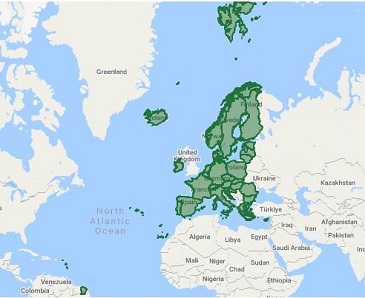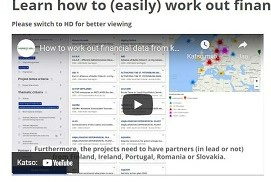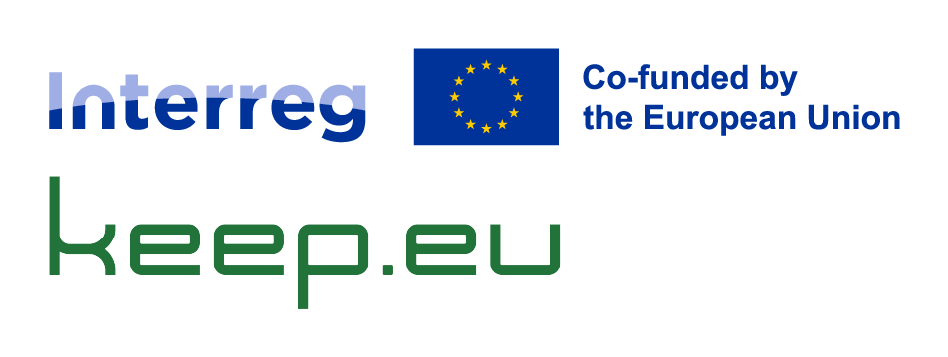News from keep.eu

One of Interact’s fields of work is the promotion of networking and thematic capitalisation.

Keep.eu recorded the first 2021-2027 Interreg project data.

We have recently added all 2021-2027 Interreg programmes to keep.eu.

We often face needs for financial information on Interreg projects…
-
2023-08-04
Keep.eu’s data contributes to promoting inclusive growth
-
One of Interact’s fields of work is the promotion of networking and thematic capitalisation, not only within Interreg but also in a broader scope, encompassing other sources of funding (ESF, Horizon Europe, among others) in such a way that Interreg results feature in the broader EU policy picture. The goal is to magnify the value of project results, namely by identifying prospect connections among programmes and funding sources, and by pinpointing project chain possibilities.
Inclusive growth is one of the thematic fields that is dearest to Interreg. After all, Interreg itself is based on the premise that no one is to be left behind.
Interreg alone has rolled out tens of thousands of projects throughout the years. The resource of capitalisation to tools such as keep.eu is therefore unavoidable, as sources of qualitative and quantitative data. Recent examples of capitalisation studies all resort to keep.eu. Among them, the following outputs should be highlighted, given the current importance of the themes that are their focus:
– Youth and employment opportunities (May 2022)
– Access to healthcare (May 2022)
– Promotion of healthy aging (September 2022)
– Skills for a quality job (August 2023)
All of the above studies can be referred to at https://www.interact-eu.net/library. Please also refer to Interact’s library for more material on inclusive growth and the inclusive growth network, and for material on capitalisation in general. -
2023-02-24
Find out about the first 2021-2027 Interreg projects
-
Keep.eu recorded the first 2021-2027 Interreg project data yesterday, from cross-border programme Austria-Germany/Bavaria.
The keep.eu team has been keeping track of all Interreg programmes’ calls, and many more data are being prepared for importing into our database.
To find out at any time how much data there is in keep.eu on 2021-2027 Interreg, go to https://keep.eu/representativeness/. -
2022-05-24
Do you know which 2021-2027 Interreg programme areas cover your region?
-
We have recently added all the 2021-2027 Interreg programmes mentioned in the Commission Implementing Decisions (EU) 2022/74 and (EU) 2022/75 to keep.eu. For the time being there is no financial or thematic information attached to the new programmes, but all the geographical areas mentioned in those decisions are loaded. Hence it is now possible to check which 2021-2027 Interreg programmes cover which country and which region, down to the smallest regional units (NUTS3).
To check the 2021-2027 Interreg programme areas receiving support from the ERDF and external financing instruments of the Union, go to keep.eu’s Programmes or its Countries and Regions areas.
Further information on the 2021-2027 programmes’ objectives, indicators etc. is foreseen to be added into keep.eu early in 2023, after all the programmes have been approved. -
2022-03-24
Renewed statistics now in keep.eu
-
Have you noticed that you can find your very own statistical overview of Interreg in keep.eu?
The tables and charts of keep.eu’s renewed Statistics now cover all the themes, all the countries and regions, all the types of Interreg programmes, all the programming periods since 2000 – and more. The four new Statistics pages have all those figures, as well as an area featuring Interreg numbers per population and area. This makes the figures much easier to compare. You can also check which countries and regions cooperate the most, on what and with which other countries and regions.
For all of those figures, use the filters to select which regions or countries you want to compare, which thematic areas, which periods, and which programmes. You can then opt for exporting the data to worksheets or export the tables or charts as images.
Also check out some interesting charts included in Statistics. Those are examples of charts for your use. Please feel free to suggest any other types of charts that you could find useful in your work. To send us your suggestion, use the contact form on the top menu of the website. We will appreciate your suggestion – and will definitely work on it.
-
2022-03-24
New calls are here – find partners and project ideas in keep.eu!
-
The first calls for new project proposals are already taking place, and hundreds of applicants are seeking for partners. It is worth keeping in mind that the Partners section of keep.eu holds well over 100k Interreg partnerships and is therefore a great source of information on potential partner organisations under all themes covered by Interreg. If you are a registered keep.eu user, you can even use keep.eu to contact them (using a form that does not disclose the recipient’s email, but with the certainty that all email addresses are periodically verified by Interact).
Also, with its over 25k projects, keep.eu can also serve as a powerful tool to find and build project ideas. Don’t hesitate to spread the word to Interreg applicants anywhere in Europe. -
2022-03-01
Interreg and the increasing carbon handprint
-
The objective of the EU Green Deal is for Europe to become the first climate neutral continent by 2050. While the objective is well-known by now, there is more to attaining it than merely reducing the carbon footprint (the negative climate impact of our activities).
Have you heard of the carbon handprint? Activities mitigating climate change are considered to leave a carbon handprint, and are hence a favourable course of action.
When searching keep.eu with the term “carbon footprint” we come up with nearly 100 projects and over 200 documents about decreasing negative environmental impacts. Many of these projects are tackling challenges towards the ambitious goal of the Green Deal, and – in fact – working to increase the carbon handprint (even if the term is not as widely used and a search with such phrase returns no projects). Below is a handful of impressive examples:
– Recycling the Future Automotive Interior, which worked out a new way to recycle fiber and raw material mixtures in textiles (like a sweater made of 70% cotton and 30% polyester) to produce yarn through new spinning methods
– BalkanROAD, helping agribusinesses to create local value chains and prove and communicate the environmental footprint of their products directly to consumers
– BEEP, working on enhanced energy efficiency of public buildings and H-CHP on that of households in remote areas, as well as
– OptiTrans and E-MOPOLI, working on greener public transport solutions and
– SMART-SPACE, addressing energy consumption of public spaces.
There is a lot to be proud of already. Let’s continue the good work to further reduce the carbon footprint and increase the handprint. -
2021-12-21
Create your lists of project output documents from keep.eu
-
With over 15,000 project output documents, and 25,500 projects (and counting), keep.eu can be a great source of thematic information, knowledge and innovation. Document search results in keep.eu can now be saved as Excel files, with the list of all the relevant documents that users can refer to in keep.eu. Moreover, the links to those documents are part of this Excel export, making life even easier for those looking for thematic knowledge produced by Interreg. In order to get hold of the documents of your interest, and their list in Excel, make a search, switch to document view and export the results. It’s as simple as that!
